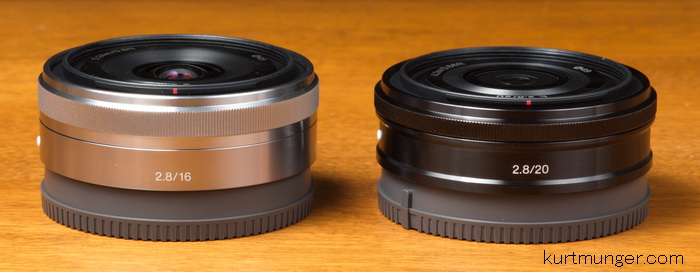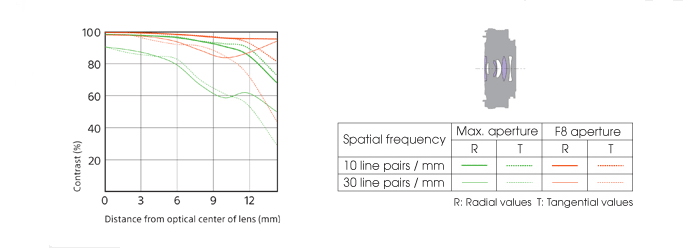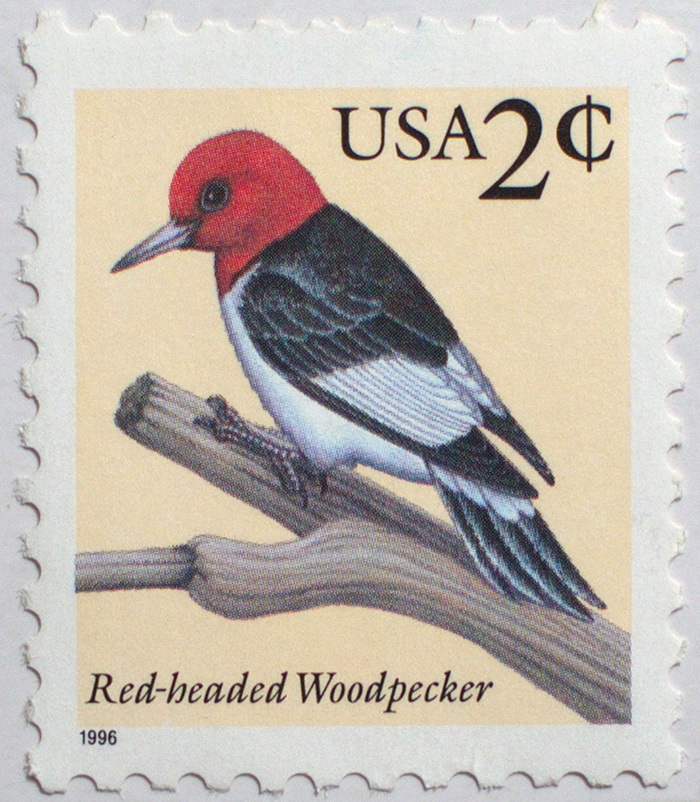|
Full review of the Sony NEX 20mm F/2.8 lens.
The Sony NEX-C3 was used for this review. For a better understanding of terms and methods used in this review, go here.
The usual center, mid-section and corner crops are located at the very bottom of the page.
Introduction.
The Sony NEX 20mm F/2.8 is the second pancake type lens for the NEX system, the first being the 16mm F/2.8, which was also the base for the wide angle and fisheye converters. The 16mm F/2.8 pancake was a neat idea, however, the optical qualities left something to be desired. With the release of the similar, but slightly longer (in coverage) 20mm early in 2013, optical concerns have been addressed, but there is some competition now in that focal length, see the conclusion for the details. The 20mm NEX lens has the same coverage as a 30mm lens in 135 film format.
Observations: the hood for the new 20mm will fit the 16mm with no noticeable vignetting, but I have no idea if you’re supposed to do that. Also, I think the converters will mount on the 20mm, but will they work appropriately? I don’t have those items, so someone may want to see if they can get usable results and report it to the Sony community. The 20mm lens is slightly shorter and lighter than the 16mm, see last product shot.
Fit and finish are very good, typical for the Sony NEX lenses in general. The lens appears to be clad in metal, with what looks like a pot metal type mounting material, the same as the 16mm. The lens is made in Thailand, or Fabriquè en Thaïlande for select Canadians.
Filter size is 49mm, which covers a lot of Sony NEX lenses, including the 16mm F/2.8. Focusing. This lens auto-focuses quickly and mostly accurately, and has a very quiet linear focusing motor so it can be used for video. The front filter ring doesn’t turn when focusing, so your polarizers and grads will work great. The focusing ring is easy to turn, and is damped about right.
In the box is the lens, front and rear caps, a small plastic slit type hood, and the owner’s manual.
Requisite product shots.
General information and specifications.
Optical qualities summary.
Lens flare/ghosting. About average for a pancake type lens, see example below.
Light fall-off. Nothing to worry about, even when adding a filter to the front of the lens hood! See samples below.
Color fringing (CA). Above average control. I see a small amount of magenta/purple along the sides of the image at high contrast edges. Also small amount of axial type (occurring everywhere in the image, and usually magenta) at F/2.8 noticeable mostly on specular highlights.
Bokeh. Just ok, with this focal length it’s hard to get backgrounds out of focus unless the subject is a couple of feet away from the lens. See crops below.
Color. Seems about the same as other Sony lenses.
Close-up filter. +4 tested, and works well when attached to the front of the lens hood.
Coma. For pixel peepers, a tiny amount at F/2.8 in the far corners of the image.
Regular filters: do not cause any additional light fall-off, even when the filter is mounted to the front of the hood.
Filter size. 49mm. Very popular for the NEX system.
Distortion. Moderate barrel with a slight wave, mostly correctable with distortion sliders, or with in camera lens corrections turned on.
Distortion example directly below.
The distortion pattern is barrel, with a very slight up-tick at the ends. Distortion correction sliders are able to almost eliminate it. People shooting with lens corrections turned on need not worry about this as it’s corrected in-camera.
Bokeh samples.
Bokeh looks just so-so when the aperture is wide open. It’s hard to get anything out of focus with this focal length unless the subject is a foot or two away. The heptagonal aperture shape shows up at F/4. In the crops above, the subject was about 18″ or .5m, and the background about 15′ or 4.5m away. Remember; bokeh is the character of out of focus highlight blur, not just parts of the image that aren’t in focus.
Light fall-off
There is not much of a problem with light fall-off or ‘corner shading’ with this lens. There is a noticeable brightening of the central part of the image from F/2.8 to F/4, but no gain from stopping down further. Adding a filter to the front of the lens hood does not cause any additional light fall-off!!
Flare and Ghosting
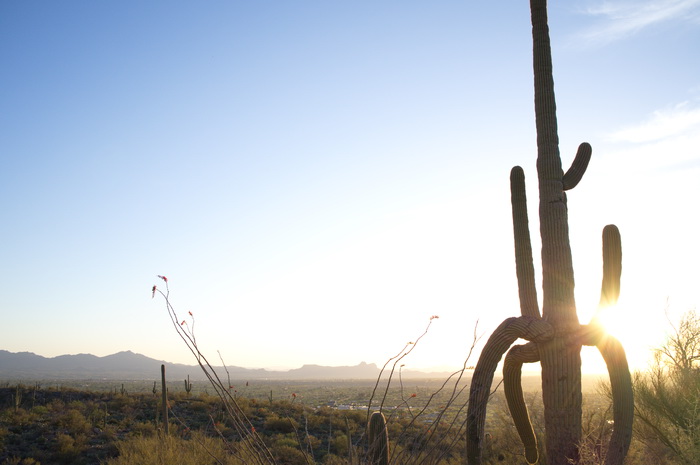 Flare and ghosting control is about average for this type of lens; I see streaks and loss of contrast when the bright sun is in the image, or just outside the image. Lowering the exposure hides some of this. There are a few small colored blobs that show up in bright conditions, especially green. Viewing your images on your camera screen may not show this stuff, it’s much more noticeable when you get home and look at the pictures on a larger screen. Image above taken at F/5.6, 1/250s.
Let’s check out the close-focus capabilities of this lens.
The sample shot was taken with the Sony NEX-C3 16.2MP camera, so don’t compare it with others that were taken with 12 or 24mp sensor cameras. The subject is a standard US stamp, 0.87″x 1.0″ or 22mm x 25mm. The shot was taken as close to the subject as focusing allowed; in this case a short 4.8″” (122mm), measured from the front of the lens hood to the subject.
The Sony NEX 20mm F/2.8 has a reproduction size of 1:8.3, (0.12x) which is small. The close focus shot is pretty sharp with good contrast, but due to the small size, it’s nothing to get excited about. Full cropped image below, no link to larger size. You can add a close up filter which seems to work well, I tested a +4, and contrast was best when mounting the filter to the lens hood.
Conclusion
The Sony NEX 20mm F/2.8 lens has some nice qualities; it’s very small and lightweight, less so than the 16mm pancake, and performs reasonable well for this type of lens. Sony corrected some of the flaws that were inherent in the 16mm, (soft sides) so in my opinion, the 20mm is what the 16mm should have been in the first place. With that said, there is some competition for the 20mm pancake, like the Sigma 19mm, and Sony 16-50mm powerzoom, both reviewed here.
Optically, the 20mm is pretty good for a pancake type lens. The distortion patten is fairly simple to fix for people using RAW converters like ACR, and will be corrected automatically in-camera on newer NEX cameras. Light fall-off is not something to worry about, even when mounting a filter on the front of the lens hood! I know that sounds crazy, but the hood is threaded for this reason. Sharpness is good in the centers at F/2.8, and gets very good at F/4. The mid-sections look good at F/5.6, but don’t quite have the crispness of the centers. The extreme sides and corners are dull at most apertures, much like the Sigma 19mm, so oh well, you can’t get perfection at this price point.
Who is going to buy this lens? If you want the most pocketable package for your NEX camera, the 20mm would be great, especially if you take pictures in low light. For people who don’t need anything quite that small, I’d get the Sigma 19mm, it’s a little sharper at F/2.8, and far less expensive. If you want the most convenience with good quality, just get the Sony NEX 16-50mm Powerzoom, it’s only a tiny bit longer and heavier, plus you get the added benefit of a zoom. Even though the Sony NEX 20mm F/2.8 is a good lens, I’d skip it and get one of the above mentioned lenses. The pancake prime lenses just aren’t all that attractive as they were a couple of years ago.
|
Full image showing crop area.
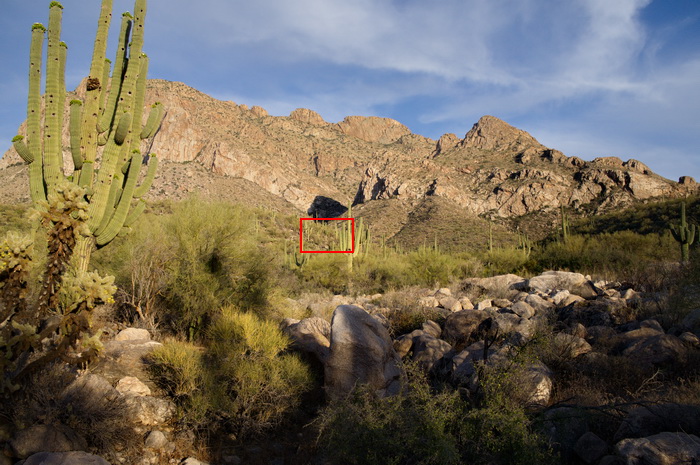
Sample crops from the centers, mid-sections and corners.
|
Center
|
Mid-section
|
Corner
|
|
|
F/2.8
|
 |
 |
 |
|
F/4
|
 |
 |
 |
|
F/5.6
|
 |
 |
 |
|
F/8
|
 |
 |
 |
|
F/11
|
 |
 |
 |
|
The centers look sharpest at F/4-5.6, with the mid-sections best at F/5.6, where they almost match the centers. The corners look quite dull at F/2.8 with gradual sharpening to their best at F/11. Landscapers use something near F/8 for the sharpest shots across the frame. Low light street shooters feel free to use F/2.8, it actually looks quite sharp in darkness. Moiré is visible on the cacti, that’s normal with digital sensors, from full frame to small point and shoot cameras. The sharper the image, the more moiré is visible. The False color can be mostly corrected in Lightroom 4 and higher versions. Exposure differences are from light fall-off. Manual focusing used.
Please check out the Sony NEX 20mm F/2.8 lens at B&H Photo and help support the site! |




